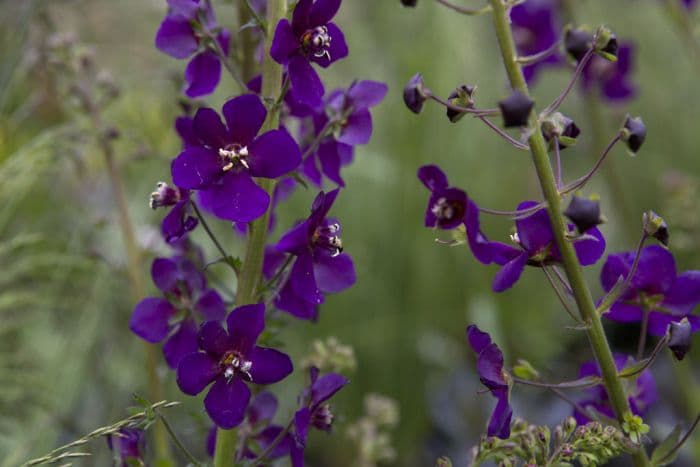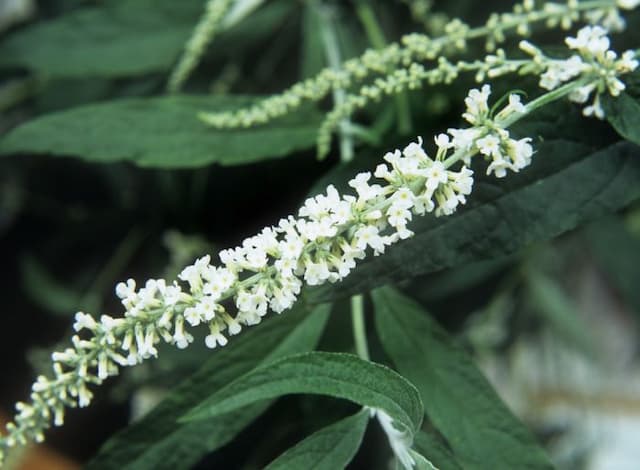Purple Mullein Verbascum phoeniceum 'Violetta'

ABOUT
Verbascum phoeniceum 'Violetta' is often referred to as Purple Mullein. It is an attractive perennial known for its striking floral display. The plant showcases a basal rosette of dark green, oblong leaves which are slightly hairy and feel a bit wooly to the touch. Rising above the foliage, it bears delicate flower spikes. The blooms are a rich violet-purple hue, neatly arranged around the slender, towering stems. Each individual flower is cup-shaped with five rounded petals, giving them a soft, classical look. The center of the flowers generally has some stamens and a fuzzy pollen structure, providing a lovely contrast against the vibrancy of the petals. The Purple Mullein's overall aspect is one of grace and subtle beauty, often attracting butterflies and bees to the garden with its bold-colored blooms.
About this plant
 Names
NamesFamily
Scrophulariaceae
Synonyms
Purple Mullein, Temptress Purple Mullein, Phoeniceum Mullein
Common names
Verbascum phoeniceum 'Violetta'.
 Toxicity
ToxicityTo humans
Purple Mullein is not commonly known to be toxic to humans. There are no widespread reports of poisoning or serious side effects associated with the ingestion of this plant by humans.
To pets
Purple Mullein is not commonly known to be toxic to pets. There are no widespread reports of poisoning or serious side effects associated with the ingestion of this plant by pets such as dogs and cats.
 Characteristics
CharacteristicsLife cycle
Perennials
Foliage type
Deciduous
Color of leaves
Green
Flower color
Purple
Height
2-3 feet (60-90 cm)
Spread
1 foot (30 cm)
Plant type
Herb
Hardiness zones
5
Native area
Europe
Benefits
 General Benefits
General Benefits- Attracts Pollinators: Verbascum phoeniceum 'Violetta', commonly known as Purple Mullein, attracts bees, butterflies, and other beneficial pollinators to the garden.
- Drought Tolerance: Once established, Purple Mullein has a good tolerance for drought conditions, making it suitable for xeriscaping and water-wise gardens.
- Low Maintenance: It requires minimal care once settled in, making it a good choice for gardeners seeking plants that don't need constant attention.
- Long Blooming Season: Purple Mullein offers a longer blooming period compared to some other garden plants, providing extended visual interest.
- Cold Hardy: It can withstand colder temperatures, which makes it suitable for planting in various hardiness zones and a valuable addition to temperate gardens.
- Ornamental Appeal: With its lush, purple flowers, Purple Mullein adds a splash of color and vertical structure to garden beds and borders.
- Wildlife Habitat: The plants can serve as a habitat for various insects, contributing to the biodiversity of the garden ecosystem.
- Easy to Propagate: Purple Mullein is relatively easy to propagate from seed, allowing gardeners to expand their plantings without extra cost.
- Soil Adaptability: It adapts well to a range of soil types, including poor soils, as long as they are well-drained.
 Medical Properties
Medical Properties- Expectorant: Traditionally used to alleviate respiratory conditions by helping to expel mucus.
- Demulcent: Contains mucilage which can soothe irritated mucous membranes.
- Anti-inflammatory: May reduce inflammation in the body.
- Astringent: Can help to tighten tissues and reduce secretions.
- Diuretic: Used in traditional medicine to promote the excretion of urine.
- Emollient: The mucilaginous properties can soften and soothe the skin when applied topically.
 Air-purifying Qualities
Air-purifying QualitiesThis plant is not specifically known for air purifying qualities.
 Other Uses
Other Uses- Dye Production: The flowers of the 'Violetta' can be used to create a natural dye for textiles, offering a range of purple hues.
- Photography: Due to their tall stature and vibrant color, Purple Mullein flowers are often used in garden photography to add height and visual interest.
- Artistic Inspiration: Artists may use the striking appearance of Purple Mullein as inspiration for botanical illustrations or garden-themed art pieces.
- Erosion Control: Because of its ability to grow in poor soil, Purple Mullein is sometimes used to stabilize soil and prevent erosion in susceptible areas.
- Crafting: Dried stalks and flowers can be used in floral arrangements or for making wreaths and other dried crafts.
- Companion Planting: Gardeners sometimes use Purple Mullein to attract beneficial insects which help in pest control for surrounding plants in the garden.
- Decorative Borders: Purple Mullein is employed as an ornamental feature in garden borders due to its tall spiky appearance and colorful flowers.
- Education: This plant can be used in educational settings like schools or botanical gardens to teach about pollination and plant biology.
- Biological Studies: It might be used in ecological studies to understand the distribution and health of native plant species in various regions.
- Living Fences: By planting them in a row, Purple Mullein can form a semi-permeable partition or living fence that adds beauty to the landscape.
Interesting Facts
 Feng Shui
Feng ShuiThe Purple Mullein is not used in Feng Shui practice.
 Zodiac Sign Compitability
Zodiac Sign CompitabilityThe Purple Mullein is not used in astrology practice.
 Plant Symbolism
Plant Symbolism- Healing and Medicinal Properties: Traditionally, Verbascum flowers, commonly known as 'Purple Mullein', are associated with their healing properties, especially in herbal medicine for treating respiratory problems.
- Protection: Mullein has been used in folk medicine and rituals to ward off evil spirits and bad luck, symbolizing spiritual and physical protection.
- Love Divination: In some folklore, Verbascum species were thought to have the power to predict love and attract the opposite sex, symbolizing romance and enchantment.
- Courage and Willpower: The erect and robust stature of the Purple Mullein stands for courage and the will to overcome challenges.
 Water
WaterPurple Mullein should be watered moderately, allowing the soil to dry out slightly between watering sessions to mimic its preference for well-drained conditions. During the active growing season in spring and summer, water approximately once a week with around one gallon per plant, depending on the size and the climate. In hot, dry periods, you may need to water more frequently, while in cooler or rainy spells, water less often to prevent waterlogging. Reduce watering in the fall and further in the winter when the plant's growth slows down.
 Light
LightPurple Mullein thrives best in full sunlight where it can receive at least six hours of direct sun daily, making it an ideal candidate for a sunny border or a south-facing garden spot. It can tolerate some light shade, particularly in hot climates, but too much shade can lead to leggy growth and fewer flowers. Ensure the chosen location is free from shadows cast by larger plants or structures to enjoy its vibrant blooms to the fullest.
 Temperature
TemperaturePurple Mullein is quite hardy and can tolerate a range of temperatures, surviving minimum temperatures down to about -20 degrees Fahrenheit. It prefers to grow in conditions where the temperature varies between 50 and 85 degrees Fahrenheit for optimal growth. Extreme heat or prolonged frost can be detrimental, so consider providing protection if temperatures go beyond these ranges for extended periods.
 Pruning
PruningPrune Purple Mullein to remove spent flower spikes and encourage a second flush of blooms. Deadheading should be done regularly during the flowering season to maintain a neat appearance and to promote more blooms. Cut back the foliage in late fall, after flowering has finished, to keep the plant healthy and to prepare it for the next growing season. Pruning is not typically needed during the winter, but any damaged or dead tissue should be removed.
 Cleaning
CleaningAs needed
 Soil
SoilPurple Mullein 'Violetta' thrives in a well-draining, moderately fertile soil mix with added sand or perlite for improved drainage. The ideal soil pH for this plant is neutral to slightly alkaline, ranging from 6.5 to 7.5.
 Repotting
RepottingPurple Mullein 'Violetta' typically does not require frequent repotting as it is a biennial plant. Repot it only if the plant becomes root-bound or the soil appears exhausted, usually every 2-3 years.
 Humidity & Misting
Humidity & MistingPurple Mullein 'Violetta' is tolerant of a wide range of humidity levels and does well in average ambient humidity found in most outdoor environments.
 Suitable locations
Suitable locationsIndoor
Ensure full sunlight and minimal water for Purple Mullein 'Violetta'.
Outdoor
Plant in full sun and well-drained soil for best growth.
Hardiness zone
Purple Mullein 'Violetta' is suitable for USDA zones 4-8.
 Life cycle
Life cycleVerbascum phoeniceum 'Violetta', commonly known as Purple Mullein, starts its life as a seed that germinates in early spring when the soil has warmed and there is ample moisture. The seedlings develop into a rosette of leaves at the soil surface, with each rosette potentially producing a tall flowering stem in late spring or early summer. During the flowering stage, the plant produces spikes of violet-purple flowers that attract pollinators and can lead to seed formation if fertilized. After flowering, seeds are dispersed by wind or fall close to the parent plant to start a new generation. Purple Mullein is a short-lived perennial or biennial, which means after one or two growing seasons, individual plants usually die, but not before potentially producing many seeds to ensure the continuation of the species. In the second year, flowering stems may be more prolific before the life cycle concludes with the plant's senescence and eventual death.
 Propogation
PropogationPropogation time
Spring-Early Summer
The most popular method of propagation for Verbascum phoeniceum 'Violetta', commonly known as Purple Mullein, is by sowing seeds. Seed propagation can be readily undertaken in late winter to early spring. To do this, sprinkle the small seeds onto the surface of well-draining seed starting mix and gently press them into the medium without covering them, as light is needed for germination. Keep the soil moist but not waterlogged, and place the container in a warm area, around 70 degrees Fahrenheit (21 degrees Celsius), with plenty of indirect sunlight. Germination usually occurs within two to three weeks. After seedlings have grown strong enough to handle and there is no more risk of frost, they can be transplanted outdoors to a sunny or partially shaded site with well-drained soil.

![Butterfly bush [Peacock]](/_next/image?url=https%3A%2F%2Fplants-admin.emdemapps.com%2Fimages%2Fplants%2F%2Fimages%2F604b634800554.png&w=640&q=75)


![Aloha [Honey Dark Yellow]](/_next/image?url=https%3A%2F%2Fplants-admin.emdemapps.com%2Fimages%2Fplants%2F%2Fimages%2F604b53868dde8.png&w=640&q=75)



